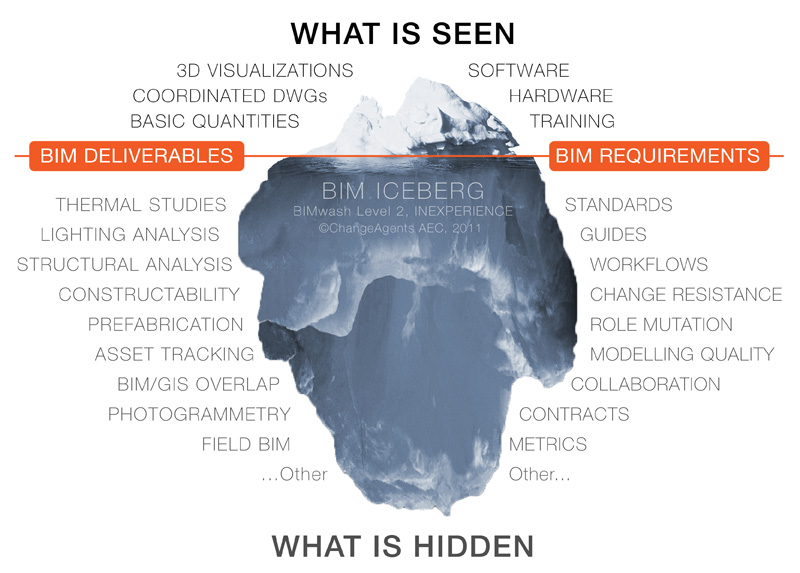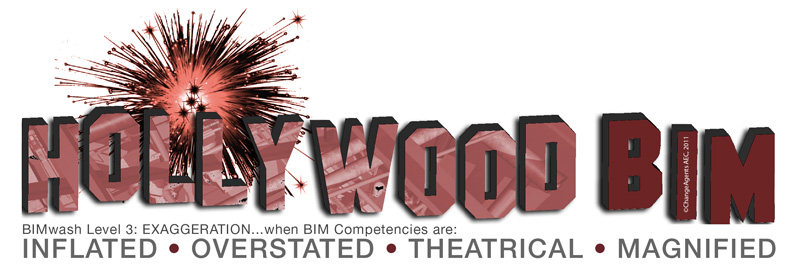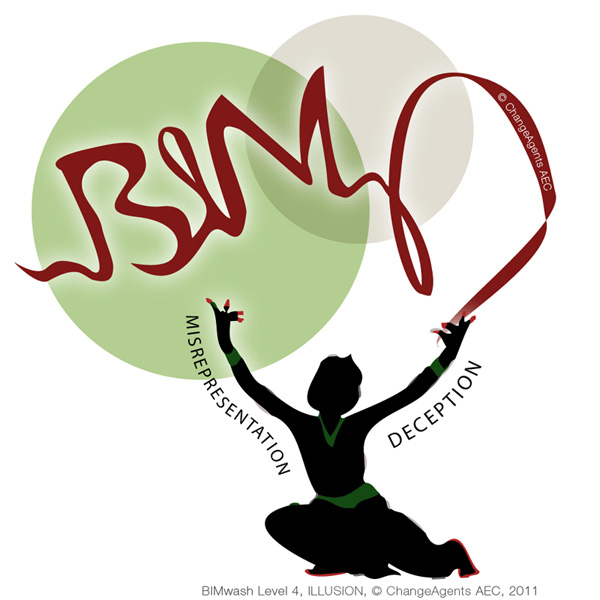Published on June 6, 2011 | Last Updated on September 13, 2025
BIM Wash[1] is a term describing the inflated – and sometimes deceptive – claim of using or delivering Building Information Modelling products or services. An organization which commits BIM Wash is typically engaged in promoting its unwarranted claims of BIM capability through its staff, website, project submissions and/or marketing material. Like Green Wash before it, BIM Wash is on the rise in markets with value attributed to BIM tools and workflows, and where clients are increasingly requiring models to be part of project submittals.
Some of the BIM Wash (BIMwash, as a newly coined single term) activity can be attributed to the confusion surrounding the BIM term itself; unintentional and even harmless to a degree. Other activities, however, are more intentionally deceptive. This is certainly true for the many attempts to sell BIM services which have not been developed yet, or fall far short of clients’ expectations.
BIMwash is not only problematic for clients who engage service providers (architects, engineers, contractors,…) falsely posing as BIM experts, it is also problematic for the service providers themselves. By muddying the waters, BIMwashers can cause significant grief to those who have invested a lot of time, money and effort in developing their true BIM capabilities and in honing their BIM deliverables.
This episode is available in other languages. For a list of all translated episodes, pleaser refer to https://bimexcellence.org/thinkspace/translations/. The original English version continues below:
Defining BIMwash
The term BIMwash is derived from Whitewash, “a cheap white paint or coating of chalked lime used to quickly give a uniform clean appearance to a wide variety of surfaces”. Metaphorically, to whitewash means to “gloss over or cover up vices, crimes or scandals or to exonerate by means of […] biased presentation of data” (Encyclopaedia Britannica, 2003).
In essence, BIMwash is the attempt to hide imperfections (BIM Incompetency), while at the same time, promoting an inaccurate view of one’s BIM capability or credentials. Using a more measureable definition, BIMwash is when:
BIM Claim[2] > BIM Competency[3]
That is, BIMwash exists when an individual, organization or project team’s BIM Claim is significantly higher than its actual BIM Competency to deliver on these claims[4]. This formula signifies that, in order to accurately measure BIMwash, BIM Competency must first be understood and measured.
Understanding BIM Competency
As a term, BIM Competency refers to a wide set of BIM deliverables and their respective requirements. Being BIM-Competent is a label that can be applied at different scales: to individuals (architects, engineers, project managers, etc…), to organizations and to project teams:
A BIM-Competent Individual is someone who has adequate BIM skill, knowledge and experience. A BIM-Competent engineer (for example) will, not only generate a data-rich 3D model using Revit, DP or Tekla, but can do it in a timely manner and according to a high delivery standard.
A BIM-Competent Organization[5] is the one that has consistently delivered (not can deliver[6]) a set of high-quality BIM products and services. It not only harbours the necessary BIM-Competent individuals but surrounds them with adequate systems, standards and due support.
A BIM-Competent Project Team is a group of organizations which – in addition to being individually competent – have gained (note the use of past tense here) the necessary experience to jointly deliver a set of BIM services/products through common standards, collaborative systems and optimized workflows.
Using the above organizational ‘scales’, let’s briefly explore how two typical, Unwarranted BIM Claims – or BIMwash – take shape.
Individual BIMwash
Unwarranted BIM Competency claims by individuals are prevalent during the process of recruitment. Individuals seeking employment within organizations those requiring some sort of BIM Competency – may claim that they have excellent BIM ‘skills’ or significant BIM experience. These claims are found in submitted résumés, promoted by recruitment agencies, or heard ad nauseam within the confines of interview rooms. Such claims may then prove to be true or – more often than not – prove to be awash with fluff and inaccuracies. Those project leaders who were on the receiving end of BIMwash can testify how a recruit – after claiming that s/he is BIM proficient during the recruitment process – turned out to be inefficient and even slowed down the whole team during a critical delivery phase[7].
Organizational BIMwash
Organizations – and by extension, Project Teams[8] – may claim specific BIM Competency in the hope of winning/satisfying clients or securing new partners or projects. These claims are specifically prevalent in marketing material (websites, presentations, capability statements, etc…) and within project submissions especially where the term ‘BIM’ has been loosely inserted by a major client into a tender request or similar. In countless cases, organizations who have publically promoted their ‘BIM Leadership’ or superior ‘BIM Capability’ have been shown to lack basic structures to deliver a reasonable-quality, BIM product[9] or service[10].
Other perpetrators of BIMwash
In addition to Service Providers[11] – the typical culprits, BIMwash is also practiced by[12]:
- Software developers and their resellers who inflate the benefits of specific tools or claim that their product is ‘a comprehensive BIM solution’.
- Clients/owners who demand a BIM product/service which they may not understand or – if delivered to them – do not have the internal capability to properly utilize and maintain.
- BIMwash by consultants and advisors who inflate the effects of their services on the BIM implementation process.
The four levels of BIMwash
Not all BIMwash is of the same intensity. Mild forms of unwarranted BIM claims can be harmless to a degree while others can be malicious and severely disruptive. To help combat BIMwash, it is useful to identify its four different levels[13]:
Level 1: CONFUSION or Unintentional BIMwash
This is when BIM processes and protocols are not understood or are perceived to be similar to CAD. It is when basic model exchanges are confused with model-based collaboration. It is when a Model Server is confused with a File Server or a Document Management System.
Those who have not yet understood the multilayered implications of BIM concepts may inadvertently confuse themselves, their clients and/or project partners (see Fig. 1 below):

Fig. 1. BIMwash Level 1, confusing X with Y
Level 2: INEXPERIENCE or Low-Level BIMwash
BIMwash caused by inexperience manifests itself when the link between a BIM deliverable and its requirements is not acknowledged or when only some BIM deliverables (the low-hanging fruit) and their requirements are understood. It is when basic BIM deliverables (like coordinated drawings or model-based clash detection) are promoted as cutting-edge innovations.
To the inexperienced, BIM is similar to an iceberg – only a small number of BIM requirements/deliverables are seen while most remain hidden below the surface (see Fig. 2). This inexperience, in the hands of a prematurely-enthusiastic marketing department, can spawn significant BIMwash.

Fig. 2. BIMwash Level 2, seeing SOME and missing MANY
Level 3: EXAGGERATION or Mid-Level BIMwash
This is when actual BIM Competencies exist but are intentionally promoted far beyond their actual level. This is similar to telling a true story yet adding several Hollywood special effects on top (Fig. 3).
One example of Exaggeration is when a national practice claims (through its BIM capability statement, website or blog) juicy BIM competencies which have only been partially achieved by a local team on a handful of projects.

Fig. 3. BIMwash Level 3, blowing things out of proportion
Level 4: ILLUSION or Severe BIMwash
This is when the BIM Competency story amounts to pure fiction. This is similar to a Bollywood movie plot – all song and dance, colourful, and possibly amusing – but the actual story was never, and may never be, true! It is when a pre-BIM service provider poses as highly BIM-competent, successfully bids-for and secures a large BIM-mandated project[14]. Under the illusion of BIMwash, true capability and severe incompetency are indistinguishable.

Fig. 4. BIMwash Level 4, promoting what does not exist!
In Conclusion
BIMwash – like Greenwash[15] before it – is expected to proliferate within the market. This is mainly driven by an exploding number of large clients who demand BIM-centric delivery. With the absence of independent assessment/certification, BIMwash skews the construction market by making those with ‘creative BIM capability statements’ indistinguishable from those with hard-earned BIM competency. Understanding BIMwash is thus the first important step towards detecting it. In a future BIM Episode, I’ll describe a few approaches to combat and – in the long run – neutralize BIMwash.
[1] This blog post is an extension of the BIMwash handout distributed during RTC Australia, 2011. The topic will be covered in two or three posts depending on feedback received.
[2] BIM Claim is what an individual, organization or project team choses to publically identify as their extent of BIM competency.
[3] BIM Competency is a term that combines BIM capability and maturity. BIM Competency can be applied to individuals, organizations and project teams. This will be further explained later on.
[4] If BIM Claim < BIM Competency, then there is a missed marketing opportunity!
[5] This also applies to Organizational Units and Groups – smaller subsets within an Organization.
[6] There is an important distinction between BIM-Competent and BIM-Ready organizations. BIM-Ready organizations are those which have the capability to deliver a high-quality BIM product/service but have not yet gained the necessary experience.
[7] While individual BIM claims are quite easy to detect, provided the recruiter/interviewer is BIM-Competent, it is still common that organizations do not assess their inductees’ BIM Competency as rigorously as they should.
[8] Example: two or more organizations submitting a joint project bid or competition entry.
[9] Sample criteria: a well-coordinated object-based model, free of modelling errors, constructable, rich in necessary data, modelled at the right level of detail, optimized in size/performance, based on a consistent/standard naming structure, etc…
[10] Sample criteria: a well-structured BIM Execution Plan, facilitated by knowledgeable senior staff, well-aware of BIM’s strengths/limitations within applicable standards and contractual commitments, etc…
[11] AEC Service Providers refer to those who offer their design and construction services to clients: architects, engineers, contractors, project managers, etc…
[12] I have intentionally left out one international group actively promoting their BIM approach as the solution to near-all industry ailments…Can you identify that group?
[13] BIMwash levels are used as a Capability Maturity metric while BIMwash types are used when describing a mixture of BIMwash behaviours.
[14] This is a true example.
[15] Greenwash is the unwarranted claim of environmental credentials.
Cite as: BIMe Initiative (2025), 'Episode 16: Understanding BIM Wash', https://bimexcellence.org/thinkspace/episode-16-understanding-bim-wash/. First published 6 June 2011. Viewed 31 December 2025

As always, an excellent commentary on current bim issues. This is one of the issues that is definitely impacting implementation and needs to be understood by all.
Keep up the good work.
Thank you Finith, great to hear from you.
Wow!!!!!!!!!
Bilal, I had an inkling that you were capable… now I know you are a giant among us. What a beautiful ‘paper!’ This would be a great article for JBIM or other publications (although it’s probably too long and in depth for their format). Thanks!
I love this paper. After 20 years trying to convince the marketplace, I now see these “mega BIM firms” running after my clients with these promises. Their nice suits and fancy cars and drinks after work. But luckily, my client love it that I am willing to crawl through a job site with them; explain every aspect of their model; and keep my promises.
Excellent piece
Many thanks David!…You’ve just made writing the next episode much more difficult :~)
Thank you aecaadgroup for your comment.
Right on target, Bilal.
Thank you Jeffrey.
The big problem is that they are selling them selves as a BIM-company, not for the big advantages there are in BIM, but for the sake of a profit. If they new what BIM really is, they wouldn’t hesitate to do it right the first time .
I agree with you Rasmus. Cutting corners, BIM washing and trying to grab at the low-hanging fruit can only be beneficial for a short while. Eventually, companies will realise the need to stop wasting time and to start investing in BIM – that is if they want to improve their long-term productivity and to maintain their competitiveness. Some realise this early; others rather late.
Jairo Clements
Great post.Really looking forward to read more. Fantastic.
Luna Ceja
I appreciate you sharing this blog post.Thanks Again. Want more.
Bilal,
as I saw this presentation at RTC Austrailia, and now reading it through, I am getting the essence of BIMwash which I otherwise was calling a BIM propaganda.
Your work is being picked up by many academics and students to reflect their understanding on BIM. But I’ve been telling my students to first explore the avenues of BIM through the applications and then go thru the BIM philosophy.
Your Doctorate work is also being picked up by students at undergrad level and they get over ambitious with their industry project.
Credit goes to your extremely progressive episodes which help develop the understanding on BIM as a process gradually and steadily.
Keep up the good work. I hope to read your paper coming out from RTC Wollongong.
Thank you Imran for your kind words; all the best to you and your students. Hope to meet you again in Wollongong if you’re attending this year as well.
I would definitely submit that the habit of exaggeration starts with the writers of the software. I have been stung many times over the past 20 years by autodesk’s lofty and inflated claims for their products. When folks begin to see this lying as some kind of acceptable industry standard, it is not surprising that they perpetuate it, either unconsciously thru their own ignorance, or intentionally, in order to take advantage of the ignorance of others.
autodesk’s motivation for lying is always the latter.
Hi Bilal, I’ve been reading your work for a better understanding of BIM. I’ve come across this bit somewhere before. I have just now realized you wrote it. I hereby express my profound respect for you and I salute you BIM-Genral Bilal 😀
Thank you Hamza; your kind words are much appreciated.
Funny and very true article. I think i will print this 4 steps and hang it on my board. In Poland BIM is still very NEW, and I have had this doubtly pleasure to hear many presentations on this subject, people just don’t get it sometimes.
Dear Bilal
I agree with you .The question Is BIM Tool or Target ,Is BIM Way or Well .
reards
haider
Thank you Haider for your comment.
Best Wishes,
Bilal
Fantastic Post! Thanks for sharing wonderful info.
Hello,
thanks for sharing such a great post with us, I glad to read it.
Wow! Amazing post. We tell BIMpostors. But, you made it much more clearer! =)
Good Post! Thanks for sharing this amazing information with us.
Thank you for sharing this work, it will be useful in the task of dissemination and training. Without a doubt, the main weapons we have to defend BIM from “BIM-whashers”
Yes, most companies offering BIM assistance do something related to 3D visualization. BIM is another level. BIM modeling is expensive, time-consuming, difficult to train about, and requires audit intensely. However, the benefits of BIM are far more significant than the initial setup and benefit the AEC industry massively at every stage of a construction project. Anyone wanting to learn more about BIM – its implementation – its scope – follow this link – https://siliconconsultant.com/blog
https://www.siliconconsultant.com/blog/blog.html
sorry for the broken link.